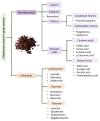Subcritical Water Extraction to Valorize Grape Biomass-A Step Closer to Circular Economy
- PMID: 38005259
- PMCID: PMC10673199
- DOI: 10.3390/molecules28227538
Subcritical Water Extraction to Valorize Grape Biomass-A Step Closer to Circular Economy
Abstract
With the increase in the world population, the overexploitation of the planet's natural resources is becoming a worldwide concern. Changes in the way humankind thinks about production and consumption must be undertaken to protect our planet and our way of living. For this change to occur, sustainable development together with a circular economic approach and responsible consumption are key points. Agriculture activities are responsible for more than 10% of the greenhouse gas emissions; moreover, by 2050, it is expected that food production will increase by 60%. The valorization of food waste is therefore of high importance to decrease the environmental footprint of agricultural activities. Fruits and vegetables are wildly consumed worldwide, and grapes are one of the main producers of greenhouse gases. Grape biomass is rich in bioactive compounds that can be used for the food, pharmaceutical and cosmetic industries, and their extraction from this food residue has been the target of several studies. Among the extraction techniques used for the recovery of bioactive compounds from food waste, subcritical water extraction (SWE) has been the least explored. SWE has several advantages over other extraction techniques such as microwave and ultrasound extraction, allowing high yields with the use of only water as the solvent. Therefore, it can be considered a green extraction method following two of the principles of green chemistry: the use of less hazardous synthesis (principle number 3) and the use of safer solvents and auxiliaries (principle number 5). In addition, two of the green extraction principles for natural products are also followed: the use of alternative solvents or water (principle number 2) and the use of a reduced, robust, controlled and safe unit operation (principle number 5). This review is an overview of the extraction process using the SWE of grape biomass in a perspective of the circular economy through valorization of the bioactive compounds extracted. Future perspectives applied to the SWE are also discussed, as well as its ability to be a green extraction technique.
Keywords: biomass valorization; circular economy; grape pomace; green chemistry; green extraction; subcritical water extraction.
Conflict of interest statement
The authors declare no conflict of interest. The funders had no role in the design of the study; in the collection, analyses, or interpretation of data; in the writing of the manuscript; or in the decision to publish the results.
Figures











Similar articles
-
The Minderoo-Monaco Commission on Plastics and Human Health.Ann Glob Health. 2023 Mar 21;89(1):23. doi: 10.5334/aogh.4056. eCollection 2023. Ann Glob Health. 2023. PMID: 36969097 Free PMC article. Review.
-
Subcritical and Supercritical Fluids to Valorize Industrial Fruit and Vegetable Waste.Foods. 2023 Jun 20;12(12):2417. doi: 10.3390/foods12122417. Foods. 2023. PMID: 37372628 Free PMC article. Review.
-
Optimization of extraction of bioactive compounds from different types of grape pomace produced at wineries and distilleries.J Food Sci. 2014 Jun;79(6):E1142-9. doi: 10.1111/1750-3841.12476. Epub 2014 Jun 2. J Food Sci. 2014. PMID: 24891032
-
Bio-sourcing from byproducts: A comprehensive review of bioactive molecules in Agri-Food Waste (AFW) streams for valorization and sustainable applications.Bioresour Technol. 2025 Sep;431:132640. doi: 10.1016/j.biortech.2025.132640. Epub 2025 May 7. Bioresour Technol. 2025. PMID: 40345341 Review.
-
Subcritical Water Extraction of Natural Products.Molecules. 2021 Jun 30;26(13):4004. doi: 10.3390/molecules26134004. Molecules. 2021. PMID: 34209151 Free PMC article. Review.
References
-
- Ritchie H., Rodés-Guirao L., Mathieu E., Gerber M., Ortiz-Ospina E., Hasell J., Roser M. Population Growth. [(accessed on 19 July 2023)]. Available online: https://ourworldindata.org/population-growth.
-
- Intergovernmental Panel on Climate Change AR6 Synthesis Report. [(accessed on 19 July 2023)]; Available online: https://www.ipcc.ch/report/ar6/syr/
-
- Comission E. Causes of Climate Change. [(accessed on 19 July 2023)]. Available online: https://climate.ec.europa.eu/climate-change/causes-climate-change_en.
-
- Parlement E. Greenhouse Gas Emissions by Country and Sector (Infographic) [(accessed on 19 July 2023)]. Available online: https://www.europarl.europa.eu/news/pt/headlines/society/20180301STO9892....
-
- European Environment Agency What Could the Summer Bring? Is Extreme Weather the New Normal? Is Europe Prepared? [(accessed on 19 July 2023)]; Available online: https://www.eea.europa.eu/en.
Publication types
MeSH terms
Substances
Grants and funding
LinkOut - more resources
Full Text Sources

